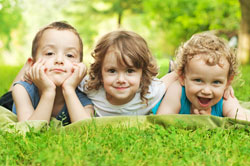Our children, teens and young adults information is currently under review. For cancer information and support, please contact our cancer nurses on 13 11 20. For information relating to paediatric cancer types, treatment and care, see The Royal Children’s Hospital and the Paediatric Integrated Cancer Services (PICS) websites, or speak with your doctor.
The most common types of cancers that happen in children are different from those seen in adults. If you would like an overview of a specific type of childhood cancer you can click on the links below.

Acute Lymphoblastic Leukaemia
What is it?
Leukaemia is a cancer of the blood that starts in the bone marrow and spreads into the bloodstream.
What types are there?
There are three types of childhood leukaemia:
- Acute lymphoblastic leukaemia (ALL)
- Acute myeloid leukaemia (AML)
- Chronic myeloid leukaemia (CML which is extremely rare)
More information
Speak with a Cancer Council nurse on 13 11 20.
Lymphoma
Lymphomas begin in cells called lymphocytes. They most often affect the small glands in the body known as lymph nodes and other lymph tissues.
What types are there?
There are two main types of childhood lymphomas:
- Hodgkin lymphomas (sometimes called Hodgkin’s disease)
- Non-Hodgkin lymphomas
More information
Call 13 11 20 for more information and support or download these Leukaemia Foundation booklets:
Childhood lymphomas on the American Cancer Society website at the links below:
Brain & Central Nervous (CNS) System Tumours
What types are there?
There are two main types of childhood brain and central nervous system tumours:
- Gliomas (Astrocytomas and ependymomas)
- Medulloblastoma
Brain tumours can be either primary (the tumour starts to grow in the brain) or secondary (more commonly called brain or cerebral metastases), which happen when cancer cells from other parts of the body spread to the brain.
What treatments are available?
The main treatment used for childhood brain and CNS tumours is surgery, where possible, often followed by radiation or chemotherapy after the operation.
For more information about individual treatments refer to our section Treating childhood cancers.
More information
Bone cancers (including Osteosarcoma and Ewing’s sarcoma)
What types are there?
The two most common types of bone cancer seen in children are:
- Osteosarcoma
- Ewing sarcoma
More information
Rhabdomyosarcoma
This is a type of soft tissue sarcoma which develops in the muscle or fibrous tissue anywhere in the body.
More information
Call 13 11 20 for more information and support or read the information on the following international cancer patient websites:
Neuroblastoma
Neuroblastoma is a cancer that develops from nerve tissue that is normally present around the chest, abdomen and adrenal glands, found above the kidneys.
What treatments are available?
The main treatment used for childhood neuroblastoma is surgery to remove the tumour, in combination with chemotherapy and radiotherapy. Newer treatments such as biotherapy and nuclear medicine are being researched to help treat children with neuroblastomas.
For more information about individual treatments refer to our section Treating childhood cancers.
More information
Call 13 11 20 for more information and support. You may also like to visit the following international websites for further information about neuroblastomas:
Retinoblastoma (eye cancer)
Retinoblastoma is a rare type of eye cancer in children. It is a tumour that affects the retina (the light-sensitive lining of the eye).
What types are there?
They are two forms of retinoblastoma:
- heritable form
- non-heritable form (unilateral)
More information
Wilm’s tumour
Wilms tumours are sometimes called nephroblastomas. They are a type of kidney cancer.
More information
Germ cell cancers
What types are there?
Germ cell tumours develop from the cells that produce eggs and sperm.
More information
Expert content reviewers:
Cancer Council Victoria with assistance from The Paediatric Integrated Cancer Service (PICS), parents and staff from the Oncology units at both The Royal Children’s Hospital, Melbourne & Monash Children's, Monash Health, Melbourne and ONTrac, Peter Mac Victorian Adolescent and Young Adult (AYA) Cancer Service.